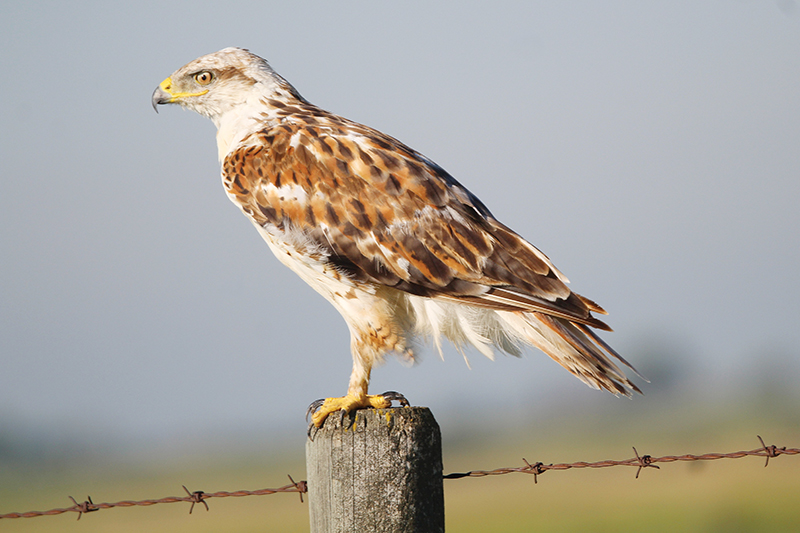

“The hawk is aerial brother of the wave which he sails over and surveys”
– Henry David Thoreau

An early morning drive to a quiet rural birding location, as the sun pokes its brightness onto the horizon, surely heals the soul. So it was as Elaine and I drove to the north end of Dalmead Lake, seeking surprise species sightings to wrap up the month of July.
As we crept south along the gravel road, with our windows down, we listened to the music. Eastern and Western kingbirds posed on posts. Savannah sparrows perched on barbed wires, singing their morning call. The jester, the black-billed magpie, shouted its hearty laugh. The morning melody of the house finch sweetened the air. A cheery call from the meadowlark echoed across the land being grazed by a relaxed herd of cattle.
Then there it was, perched placidly on a fence post, mere yards from the gated entrance to the lake. Wondrously white, painted with shades of rust and hues of brown, our first opportunity to be so close to a ferruginous hawk began. Larger than a Swainson’s hawk, this large-headed, gopher-eating buteo radiated a serenity so needed on our stressed planet. For ten seconds, likely less, we marveled at what was perhaps a once-in-a-lifetime encounter with this hawk.
At home on Alberta’s southeastern grassland region, the ferruginous hawk uses a variety of tactics to capture prey. Using a perch to detect small mammals, searching on the wing, standing on the ground and striking, or using strong winds to hover or kite, are all methods to obtain food. With a bounty of gophers available in the grasslands, the ferruginous hawk can’t empty nature’s cupboard. Prairie dogs, hares, and cottontail rabbits complement the gourmet gopher menu. When migrating on the Alberta side of the Rockies, this hawk will consume the same food sources down into the southern states, continuing the grasslands life.
There is both bad news and good news about the Alberta ferruginous hawk population. In 1992, Alberta was home to 1700 mating pairs. A mere eight years later, a steep decline to 700 pairs caught the attention of the Alberta government. The provincial government listed this hawk as an Endangered Species under the Alberta Wildlife Act. The federal government identified the buteo as Threatened under its Species at Risk Act.
The province created a Ferruginous Hawk Recovery Plan in 2009 which identified specific strategies to halt the decline. These strategies included reducing human disturbance at nesting sites, maintaining existing habitat, ensuring there are adequate numbers of nesting sites, maintaining and enhancing prey populations, and reducing human-caused mortality. In 2022, pair estimates for southeastern Alberta ranged between 454 to 963.
Elaine’s shutter button clicked. In a sliver of time, the hawk eased itself from its perch and proceeded east into the grasslands. It had become a part of the music, playing its role in the broad band of birds and wildlife on a sunny and peaceful Wednesday morning.
